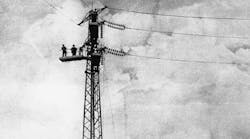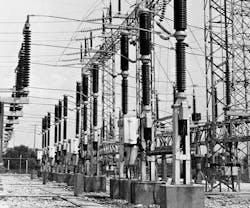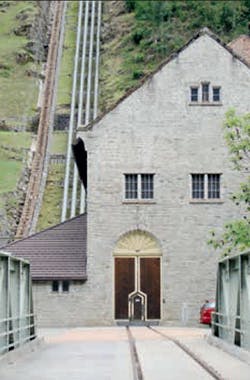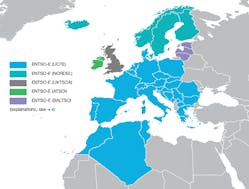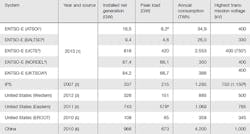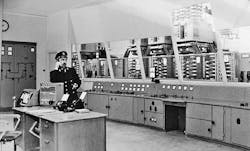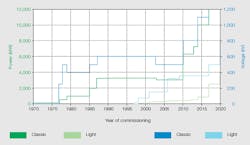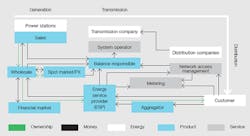Electrical energy was first discovered in a DC form and its early applications in communications, transmission and lighting used low-voltage DC. It is thus no surprise that the first urban distribution networks were also DC. Even the first long-distance transmission of electricity (57 km between Miesbach and Munich in Germany, in 1882) used DC technology. These early efforts predated the emergence of three-phase AC technology, whose development was to start in Europe and which was to be advanced in the United States by Nikolas Tesla and George Westinghouse.
The main driver for the transition to the three-phase AC system was the possibility of converting voltages in transformers. Transformer made it possible to transmit power at low-losses by converting to voltages too high for direct use in applications. This transmission efficiency made using larger centralized power plants possible and thus introduced economies of scale. Another important advantage of AC was the better interruptibility of short-circuit currents – even today high-voltage DC power switches exist only as prototypes. And last but not least, the very simple conversion of electrical energy into mechanical energy and vice versa in induction machines was a major advantage of AC.
In 1891 on the occasion of the International Electrotechnical Exhibition in Frankfurt, Germany, the successful transmission of three-phase AC was demonstrated over a distance of 176 km between Lauffen and Frankfurt. The demonstration was a collaboration between AEG and Maschinenfabrik Oerlikon. It was realized under the leadership of the three-phase pioneer Mikhail Osipovich Dolivo-Dobrovolsky of AEG. Maschinenfabrik Oerlikon's contribution was led by Charles Eugene Lancelot Brown, who was later to become one of the founders of Brown, Boveri & Company (BBC).
The breakthrough of the three-phase AC system in the United States came about when the lighting of the Chicago World’s Fair in 1893 was entrusted to George Westinghouse. Westinghouse significantly undercut Thomas Edison's DC bid. His victory was a decisive factor in AC winning the "War of the Currents."
The emergence of long-distance supply systems
In the first half of the 20th century, previously stand-alone island networks were progressively interconnected to larger and ultimately national grids. A structure emerged for power systems that still holds its own today:
1 Brown Boveri
2 Hydropwer has a strong geographic dependency and thus often requires long-distance transmission.
It features system-wide interconnectivity ➔ 1, a meshed high-voltage transmission level connecting to subordinate regional high-voltage networks, and underlying medium- and low-voltage distribution networks extending across both city and rural areas. The reasons for merging the local island networks are the higher efficiency of larger power plants, the lower reserve power capacity and the use of location-bound primary energy sources, especially hydropower and lignite. The transportation of these in their primary form is not economical due to their low energy density ➔ 2. Because the electrical power supply was recognized early on as a key economic infrastructure and a natural monopoly, virtually all countries either nationalized or regulated it at an early point.
With the emergence of large systems commenced the mode of operation that is still valid for all of the major electrical energy supply systems in the world ➔ 3. The two main requirements the system must fulfill are that it must assure a balance between supply and demand (as shown on the left hand-side of the figure) and the specified voltage parameters must be maintained at the transfer points (right hand side).
3 Main functions in the electrical supply system
The challenge of operating such a large, geographically distributed and composite system in real time without the availability of today’s high-performance communication technology was approached by deploying a comprehensive planning process using such tools as unit control and load distribution and with the objective to minimize remaining uncertainties. The latter must be managed in real time. Control of remaining deviations takes advantage of the fact that the frequency is available almost instantaneously across the system. Mismatch between consumption and generation can be measured using the resulting deviation in frequency, which provides a signal for appropriately equipped control power plants to modify their output and correct the mismatch.
Largely independent of these power management activities is grid control. Grid control uses the control settings of the transformers located between the different high-voltage levels and those between the high and medium-voltage level as well as the reactive power in-feed from the power plants to adjust the load flow and grid voltages. Voltage regulation normally ends at the medium-voltage level. The connection between the medium- and low-voltage levels uses transformers with fixed ratios.
In principle these two processes are separate. However in practice they are interrelated because of the use of plants for the local control of reactive power, and because transmission bottlenecks require power plants to be operated outside of the system-wide operating cost optimum.
The final important statement contained in ➔ 3 is that the operation of large interconnected synchronous grids on the primary distribution level is achieved with a small number of centrally placed elements such as large power plants and switching facilities. For example, in typical European network structures, switching facilities on the primary level represent less than 2 percent of the total switchgear.
In the second half of the 20th century, national grids were interconnected across borders to form transnational synchronous grids. These developments were driven by the quest for higher profitability and greater security of supply. In Europe, the creation of the Union for the Co-ordination of Production and Transport of Electricity (UCPTE) in 1951 laid the foundation for the emergence of a European synchronously operated system. The technical implementation began with the connection of the grids of France, Switzerland and Germany at the “Star of Laufenburg” (Switzerland) in 1958 – long before the idea of a European electric market was born. Today one single synchronous grid stretches from Portugal to Poland and from the Netherlands to Turkey. It has now also been synchronized with Morocco, Algeria and Tunisia ➔ 4.
4 The main synchronous grids of Europe
Parallel to the emergence of the interconnected continental European system, the Scandinavian Nordel system was created as was the Interconnected Power System (IPS) of the (then) Soviet Union and the countries in its sphere of influence. The latter is to date the world’s geographically most extensive synchronized system in the world. A slightly different approach was adopted in North America: Although synchronous systems were created covering several states, synchronous operation was not extended across the continent. Today, there are three synchronously operated areas interconnected by HVDC couplings. Presently, China has the largest synchronized power system in the world (in terms of power) and is still rapidly evolving. The key data of some important synchronous grids are compared in ➔ 5.
5 Key data of selected synchronous grids (see full article for footnotes and references for this chart)
The different maximum voltages in these transmission networks reflect the different geographical size of the systems. Because reactive power requirements limit the maximum stable operable length, long-distance transmission requires either high-voltage or low frequencies.
High-voltage direct current transmission
Although the benefits of AC technology led to its ubiquitous adoption, the growth in size of synchronous grids also highlighted its drawbacks. Systems began to approach the limits of stable transmission, especially where cable transmission was used (introducing highly capacitive reactive-power requirements). The importance of submarine cables in the Scandinavian countries prompted these to begin looking into high-voltage DC transmission (HVDC) in the 1920s. The pioneer of this technology, August Uno Lamm, spent more than 20 years working on this challenge at ASEA. The first commercial link went into operation in 1954, connecting the island of Gotland in the Baltic Sea to the Swedish mainland grid ➔ 6.
6 The Gotland control room in the 1950s
During the subsequent decades, HVDC transmission established itself as the technology of choice for transmitting high power over long distances. The construction of increasingly large hydroelectric power plants has remained the main driver of HVDC development ➔ 7 – for example, Cahora Bassa in southern Africa, Itaipu in South America, and since the 1990s, several large projects throughout China. The current peak values are (in different systems) 6,400 MW, 2500 km and 1100 kV DC.
7 Development of HVDC parameter
Liberalization of the electric energy supply
Towards the end of the 20th century, many countries began to question the requirement for a full vertical integration of the electricity industry. The discussion first arose in the United States, the United Kingdom and Scandinavia, culminating in the liberalization of the electric energy supply in those countries. Later Australia and the European Union followed suite. In countries in which the power supply had been state-owned, this step also led to its privatization. Despite these parallel developments, the actual motivations for the change were not uniform. Reasons included the wish to attract private investment into the energy supply, the desire to improve the quality of supply and the objective of reducing energy prices through competition.
Liberalization required a separation of the electric power business and the operation of the network infrastructure. Although the networks were still treated as natural monopolies and therefore regulated by the state, the generation of electrical energy became a competitive market. However, different countries opted for different manifestations of this liberalization. In Europe, end customers can participate in the competitive market directly by choosing between different suppliers. In North America, in contrast, territorial monopolies remain on a distribution level, with competition being limited to the wholesale level.
8 Technical and commercial roles in an electricity market with full retail competition.
Liberalization also introduced new market roles, not only in the area of commercial optimization and interaction with customers but also in ensuring a continued stable operation of the system. These roles are shown in ➔ 8 along with the basic technical functions retained from the previous setup. Liberalization effectively ended integrated planning of power stations and networks, both in terms of development and operation. Real competition between the power plants of different locations requires a greater transmission capacity than is required for an integrally planned system. However, it calls for operational coordination between market players and standards for cooperation.
Electricity supply 2.0
Since the beginning of the new millennium, many countries have moved towards strong support and promotion of new renewable energy sources, ie, mainly solar and wind ➔ 9.
9 The huge growth of wind and solar energy of recent years has created new challenges.
While this rapid development has introduced technical challenges for grids, it has also contributed to a strong reduction in energy cost, especially in photovoltaics. The result is that in an increasing number of countries energy can be provided at a price below that paid by consumers on the low voltage network. Because photovoltaics displays an almost linear cost structure (without significant economies of scale in the investment costs) it is having a fundamental impact on the economics, and hence also the structure, of the electricity supply. The main characteristics of this impact, from a technical systemic perspective are:
A greater geographic separation between generation and consumption is introduced to systems previously built mainly around fossil fuels or nuclear energy and which previously balanced consumption and generation on a regional level. This development is driven primarily by strong location-dependent primary energy sources such as wind and water.
Distributed generation is increasing mainly because of photovoltaics and combined heat and power and will cause a significant share of generation to be covered by a very large number of small units.
Volatile production from wind and solar energy is leading to faster and larger supply-side fluctuations of only limited predictability.
These three changes have technical implications in all aspects of the supply and use of electrical energy ➔ 10. Two changes are particularly noteworthy: the growing importance of long-range and high-performance transmission networks and the integration of highly-distributed elements, both on the production side and on the consumption side (smart management of consumption).
10 Effects of the main drivers for change on different parts of the electrical energy supply chain. (See full article for footnotes.)
With the large-scale installation of renewable generation, the ability to effect long-distance compensation of different primary energy sources is increasingly advantageous, for example in the form of connections from North Africa and the Middle East to Europe [1]. Such a verylong- distance transmission network is expected to be installed as an additional layer over the existing high-voltage grids as a so-called overlay network. With the introduction of its DC circuit breaker in 2012, ABB removed the last major technical hurdle to achieving this with HVDC technology [2].
Of all the changes ahead, distributed generation will probably have the most far-reaching effects. With a large portion of the generating capacity being connected at the distribution level, this new phenomenon must be integrated into the system management. Furthermore, in the case of solar energy, the pronounced infeed peaks call for congestion management on the distribution level. To achieve active coordination, up to three orders of magnitude of additional components will be needed than was the case in past systems. Information and communication technology will play a crucial role. Efficient information gathering and its consistent use for planning, operation and maintenance will be crucial for the economic operation of decentralized networks.
There is another change afoot, not caused by renewable energy, but by technical developments: Although in the early days of electrification, three-phase AC was predominant both on the production and on the application side, now more and more devices are found in systems that either require DC or are neutral with respect to frequency. Examples on the consumption side are electronic devices, LEDs, batteries and inverter-driven motors, and on the production side, solar cells. There is therefore a growing economic case for DC distribution. ABB recognized this and has, for example, developed offerings for data centers [3] and ships [4]. The three-phase AC world is becoming increasingly hybrid not only on the transmission level, but also in distribution.
These developments are bringing about changes in the fundamental principles of electrical energy supply and challenges principles that have stood unchanged since the very early days of AC. It is therefore no exaggeration to speak of the transition into a new phase: Electricity 2.0.
DOWNLOAD FULL ARTICLE [PDF] (with footnotes)
Jochen Kreusel
ABB Smart Grids
Mannheim, Germany
[email protected]
--------------------------
References
[1] Desert Power: Getting Started. Dii GmbH, München, June 2013
[2] J. Häfner, B. Jacobson, Proactive hybrid HVDC breakers – a key innovation for reliable HVDC grids. Cigré Symposium, Bologna, Italy, September 13–15, 2011
[3] A. Schärer, Dc for efficiency, ABB Review 4/2013, pp. 16–21
[4] Breakthrough order for DC technology, ABB press release, 22.02.2012
